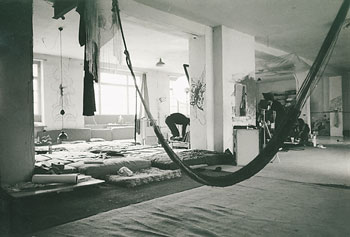Kommune 1
![]()
Berlin, Germany
Counterculture Commune
Free Love
1967 - 1969

Berlin, Germany
Counterculture Commune
Free Love
1967 - 1969

Kommune 1, a group of nine and one child, emerged from the Socialist German Student Union (SDS) and was part of a wave of youth movements, from the Summer of Love in San Francisco to the May ‘68 protests in Europe. The anti-authoritarian activists, raised in the post-war but still-walled-city of West Berlin protested against US imperialism, the war in Vietnam, and the fascist oppression of the nuclear family. They called for the destruction of the bourgeois through sexual liberation, the abolition of private property, and rejected work in favor of pleasure. They were sharp-edged hippies, practicing militantly-enforced free love. The group lived in several apartments during it’s 35 month run, before moving into an old factory on Stephanstrasse. The group practiced radical communality, removing doors from toilet stalls to destroy the bourgeois conceits of privacy and modesty. They slept in one room, on mattresses on the floor, and played phone calls over a loudspeaker.
The group was known for satirical political protests and stunts, including the planned “pudding assassination” of the US Vice President Humphrey, embroiling them in accusations of a Maoist plot, court cases, and fines. The resulting press frenzy catapulted Kommune 1 to fame, charging thousands of marks for interviews with the press. Uschi Obermaier and Rainer Langhans became poster children for sex, drugs, and rock and roll. The group imploded, drug addiction, political divisions, and a final confrontation with a motorcycle gang brought the commune to an end.





Nam semper semper ex
In porttitor pellentesque sapien